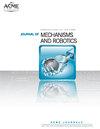Single-actuated camshaft robot with multiple sequential motions
IF 2.2
4区 计算机科学
Q2 ENGINEERING, MECHANICAL
Journal of Mechanisms and Robotics-Transactions of the Asme
Pub Date : 2023-07-18
DOI:10.1115/1.4062987
引用次数: 0
Abstract
Pipeline inspection in unknown environments is challenging for robots, and various In-pipe crawling robots have been developed in recent years to perform pipeline inspection. Most of these robots comprise multiple segments and require multiple actuators to realize the pipeline locomotion, resulting in complicated system composition and large energy consumption. In this paper, inspired by the crawling principles of earthworm locomotion, we propose a single-actuated camshaft robot that can realize multiple sequential motions for pipeline crawling. The proposed singled-actuated camshaft robot contains one actuator and three segments: head anchoring, body elongation, and rear anchoring segment. The multiple sequential motions of these three segments are realized based on the cam mechanisms. Umbrella-shaped elastic rubbers are longitudinally arranged around the head and rear anchoring segments. Each segment contains a cam bracket. The camshaft's rotatory motion pushes the cam brackets to generate the axial translational motion, resulting in the umbrella-shaped elastic rubbers being expanded or contracted. The proposed camshaft robot's expansion and contraction motion are sequentially realized by the phase deviation of the camshafts. First, the structures of the proposed robot are designed. Then, the cam curves are modeled, the expansion/contraction ratio of the rear/head anchoring segment is calculated, the phase deviation of the camshafts is determined, and multiple sequential motions of the proposed robot are simulated. Finally, we fabricate the proposed camshaft robot and carry out crawling experiments in pipelines with different shapes and diameters.具有多个连续运动的单驱动凸轮轴机器人
未知环境中的管道检测对机器人来说是一项挑战,近年来开发了各种管道内爬行机器人来执行管道检测。这些机器人大多包括多个节段,需要多个执行器来实现管道运动,导致系统组成复杂,能耗大。在本文中,受蚯蚓运动爬行原理的启发,我们提出了一种单驱动凸轮轴机器人,该机器人可以实现管道爬行的多个顺序运动。所提出的单驱动凸轮轴机器人包含一个致动器和三个部分:头部锚固、身体伸长和后部锚固部分。这三个部分的多次连续运动是基于凸轮机构实现的。伞状弹性橡胶纵向设置在头部和后部锚固段周围。每个扇形段都包含一个凸轮支架。凸轮轴的旋转运动推动凸轮支架产生轴向平移运动,导致伞状弹性橡胶膨胀或收缩。所提出的凸轮轴机器人的伸缩运动是通过凸轮轴的相位偏差依次实现的。首先,设计了该机器人的结构。然后,对凸轮曲线进行建模,计算后部/头部锚固段的膨胀/收缩比,确定凸轮轴的相位偏差,并模拟所提出的机器人的多个顺序运动。最后,我们制作了所提出的凸轮轴机器人,并在不同形状和直径的管道中进行了爬行实验。
本文章由计算机程序翻译,如有差异,请以英文原文为准。
求助全文
约1分钟内获得全文
求助全文
来源期刊

Journal of Mechanisms and Robotics-Transactions of the Asme
ENGINEERING, MECHANICAL-ROBOTICS
CiteScore
5.60
自引率
15.40%
发文量
131
审稿时长
4.5 months
期刊介绍:
Fundamental theory, algorithms, design, manufacture, and experimental validation for mechanisms and robots; Theoretical and applied kinematics; Mechanism synthesis and design; Analysis and design of robot manipulators, hands and legs, soft robotics, compliant mechanisms, origami and folded robots, printed robots, and haptic devices; Novel fabrication; Actuation and control techniques for mechanisms and robotics; Bio-inspired approaches to mechanism and robot design; Mechanics and design of micro- and nano-scale devices.
 求助内容:
求助内容: 应助结果提醒方式:
应助结果提醒方式:


